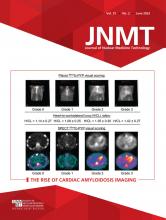Abstract
White adipose tissue (WAT) usually shows negligible 18F-FDG uptake due to negligible glucose utilization. However, corticosteroids alter the biodistribution of 18F-FDG and increase uptake in WAT. Here, we present a case of diffusely increased 18F-FDG uptake in WAT secondary to high-dose corticosteroid therapy for nephrotic syndrome.
A 12-y-old girl with a known case of lymphoma was referred to the Department of Nuclear Medicine for end-of-treatment PET/CT after 4 cycles of chemotherapy (doxorubicin, bleomycin, vinblastine, and dacarbazine). The patient had also been receiving prednisolone (2 mg/kg of body weight per day) for 2 wk for nephrotic syndrome. The patient was prepared for 18F-FDG PET/CT with overnight fasting. On the day of the scan, the fasting glucose level was 105 mg/dL, and PET/CT was performed 45 min after intravenous administration of 148 MBq (4 mCi) of 18F-FDG. Maximum-intensity projections (Fig. 1) revealed diffuse 18F-FDG uptake throughout the body, reduced uptake in physiologic sites such as liver, and no site of pathologically increased uptake to suggest residual disease. The transaxial slices revealed that the uptake was localized in the subcutaneous white adipose tissue (WAT), and there was a complete metabolic response to treatment, with a Deauville score of 1. Normally, WAT shows minimal 18F-FDG uptake, but our patient showed increased 18F-FDG uptake within the WAT. This unusual finding has been reported in the literature in patients receiving high-dose corticosteroid treatments (1–3) and in HIV patients with lipodystrophy on antiretroviral therapy (4–6).
18F-FDG PET/CT images of 12-y-old girl with lymphoma being evaluated for treatment response. (A) Maximum-intensity projection reveals diffuse uptake throughout body, with reduced uptake in physiologic sites such as liver and no site of pathologically increased uptake (B, C, and D) Transaxial thoracic, abdominal, and pelvic slices, respectively, show uptake localized to subcutaneous and visceral WAT. Cause of this unusual finding was determined to be corticosteroid therapy for nephrotic syndrome.
WAT is metabolically inert, serves to provide the body with the energy substrate by undergoing lipolysis, and has negligible glucose uptake, thus showing negligible 18F-FDG uptake (3,7). However, corticosteroids are known to induce adipocyte hypertrophy (i.e., anabolic lipogenesis) and adipocyte hyperplasia in WAT, as well as catabolic lipolysis, ultimately leading to a cushingoid habitus (3,4). Steroids induce adipocyte differentiation and increased glycolytic metabolism in the mitochondria, aided by steroid-induced hyperglycemia, secondary hyperinsulinemia, and increased expression of insulin-sensitive glucose transporters on WAT, leading to increased localization of 18F-FDG within WAT. Steroids are also believed to induce a proinflammatory milieu and increased macrophage recruitment within WAT, further enhancing 18F-FDG localization within WAT (8). This increased localization can affect the interpretation of PET/CT images. It can alter semiquantitative parameters such as SUV and metabolic tumor volume and can obscure superficial lesions, especially in neoplasms with limited 18F-FDG avidity. The present case demonstrates these molecular effects of steroids on lipid homeostasis by revealing increased 18F-FDG accumulation in WAT secondary to high-dose prednisolone treatment for nephrotic syndrome.
DISCLOSURE
No potential conflict of interest relevant to this article was reported.
Footnotes
Published online May 16, 2023.
REFERENCES
- Received for publication December 13, 2022.
- Revision received February 7, 2023.








